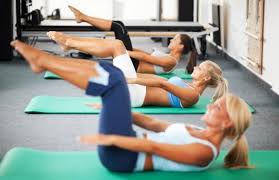It is all too easy as the nights draw in to lapse into hibernation mode and let our exercise and health regimes fall by the wayside. Self motivation and routine can soon be lost and it becomes harder and harder to get back on track the longer we leave it…..that’s if you ever were on track. Now is the time to have an action plan to get you through Autumn and winter without feeling those ‘winter blues’ and be ready to hit the Spring months fighting fit. Sticking to it can be another problem. Just try to remember that;
” The biggest risk from exercise is not starting”
If you do already attend a gym or exercise class, aim to set yourself some goals to achieve by Christmas. If motivation is an issue get yourself a ‘gym buddy’ to help encourage you along or try a few personal training sessions to spur you on. Group classes can be a great motivator such as circuits, Yoga and Pilates, which are also great for general strength and all-round fitness. Home programmes from a DVD or online can be useful if you can not get to the gym or to a class. You can also watch them first to get a feel for it and learn the techniques at your own pace.
If the thought of exercise fills you with dread, just remember, ” There are more ways to crack a nut”. Exercise does not have to punish you in the process by being excessively hard. Making it fun and keeping to a progressive programme is paramount to success. So you need to get it right from the start, as many good intentions fail due to unrealistic expectations or more commonly, Injury.
As a general rule, if an exercise or movement in the gym doesn’t feel right, or feels painful or awkward, then it is probably not going to do you any favours in the long run and possibly cause you to injure yourself. Check that you are performing the movement correctly by either having someone watch and correct you, or film yourself doing the action and check that you can ‘hold your form’ throughout the move. If not then the ‘Load’ may be too heavy, or your body may just not be able to get into the correct position to do that particular exercise safely.
However, don’t worry, as there will always be an alternative exercise or movement that you can do which will target the same area. You may just need a little help finding it or have to think out of the box. If you do not feel you are fit enough to get started, or you are worried about an injury or problem joint, a one off session with a physiotherapist can be a good idea to set you on the right track.
A good physiotherapist should be able to assess and diagnose Musculoskeletal problems and identify any conditions contributing to an injury. It is vital to determine the stage of healing of an injury and Identify repetitive faults with posture or dysfunctional movement patterns, in order to guide an individual on a safe return back to exercise, without the risk of relapse.
Physiotherapy can ‘ Facilitate healing’ through hands on treatment, electrotherapy, exercise and rehabilitation prescription, , “The fix comes from within”.
Most injuries of the bodies structural tissues have a predetermined rate of healing, which can be optimised but not accelerated, so the correct advice and intervention at the appropriate time is imperative. Never under estimate the bodies ability to heal and get stronger, as, as long as the conditions are right the body should respond.
Do not forget the golden rules for healing:
-
Eat well ( Do not that Vitamin D supplement through the winter whilst UV light exposure is low , especially in the North of England).
-
Sleep well ( This is when the body heals itself).
-
Listen to your body ( No pain No gain, does not always apply).
-
Seek advice if unsure about what exercise to pursue or how to get started.
Good luck.





